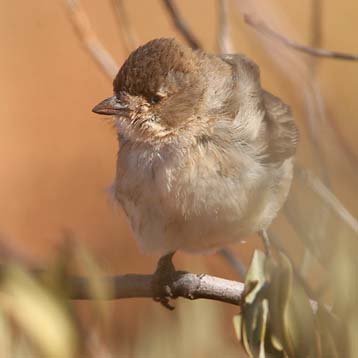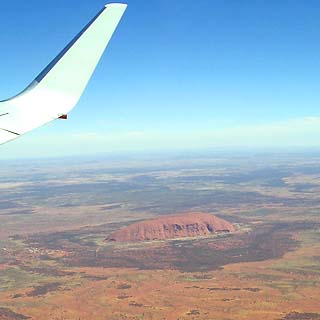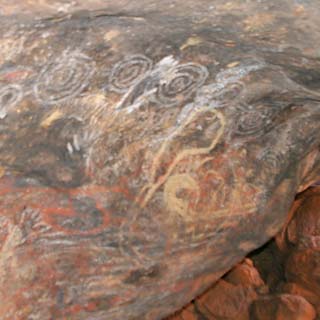
Nonetheless we had a fine time watching and photographing the birds we did locate, including Hooded Robin, found daily during visits to Simpsons Gap (male, below left), and Western Bowerbird, which was a tame denizen of the picnic grounds at both Simpsons Gap and Ormiston Gorge (male, below right). |
||
|
||
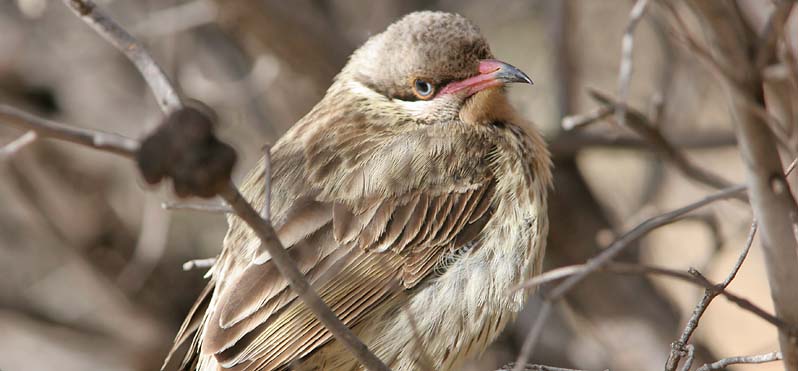 |
||
Two other spots right outside Alice Springs were very worthwhile. In the late afternoons at Heavitree Gap Lodge, one can feed wild wallabies [see our Mammal page]. Nearby are the Alice Spring wastewater treatment ponds (below; with Straw-necked Ibis). Access is arranged downtown through the Dept. of Water & Power, and requires signing a waiver and obtaining a key during a work day [making it impossible to arrange on short weekend visit], but the ponds were great. |
||
 |
||
Ducks and waders were well represented at the ponds, including the first Siberian migrants here in August (e.g., Wood Sandpiper). We had nice scope views of loads of Red-necked Avocet (below left). The best species encountered was an entirely unexpected Black Falcon (below right; a digiscoped shot). I also had the opportunity to capture by camera the photogenic male White-winged Fairywren (fullscreen shot below). |
||
|
||
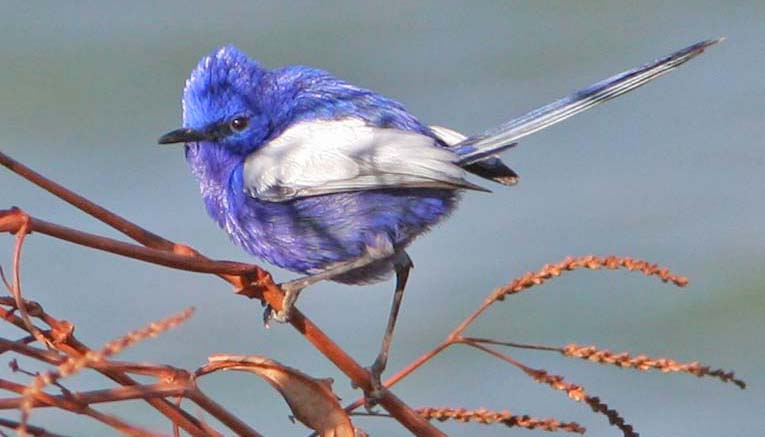 |
||
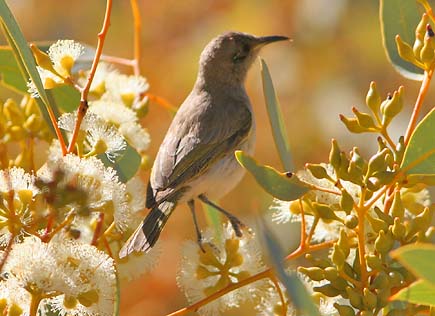 By
tapping into chat lines about Australian birds using the Internet at
our motel in Alice [Toddy's Backpackers Lodge], we learned that a Grey
Honeyeater — a rare species of the interior — had been seen at
flowering shrubs at Serpentine Gorge. The flowers were in even greater
profusion when we visited, and although Brown (left)
and Spiny-checked Honeyeaters were dominant there, we did get nice
views (but no pics) of Grey Honeyeater. Also a spring migrant Rainbow Bee-eater had arrived (below), making Rita happy, given her affinity to that genus. By
tapping into chat lines about Australian birds using the Internet at
our motel in Alice [Toddy's Backpackers Lodge], we learned that a Grey
Honeyeater — a rare species of the interior — had been seen at
flowering shrubs at Serpentine Gorge. The flowers were in even greater
profusion when we visited, and although Brown (left)
and Spiny-checked Honeyeaters were dominant there, we did get nice
views (but no pics) of Grey Honeyeater. Also a spring migrant Rainbow Bee-eater had arrived (below), making Rita happy, given her affinity to that genus. |
||
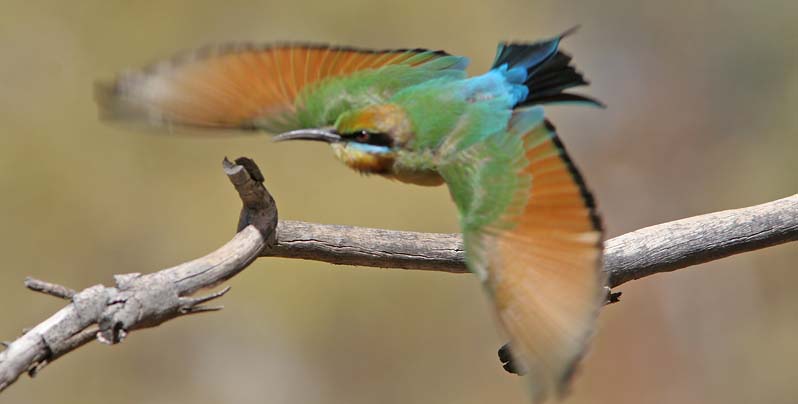 |
||
 |
||
Murray Lord and other trip reports had given us a couple of stops enroute to try, particular 21 km north of Erlunda and another 20.4 km west of Erlunda (Erlunda is where one turns west towards Uluru). We did not see everything we wanted, but found a foraging flock of Chiming Wedgebill (one shown below left), a close Southern Whiteface (below right), and then an absolutely gorgeous Mulga Parrot (fullframe below). |
||
|
||
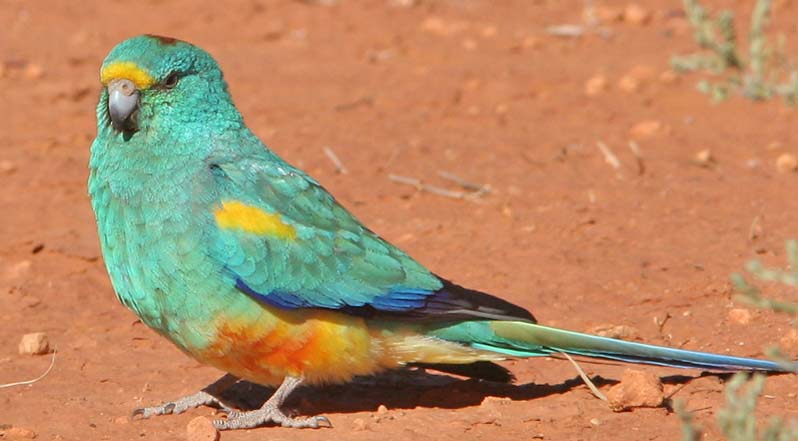 |
||
 |
||
Birding
at Uluru was rather sparse, but of course we spent time exploring
around the great rock [above, at sunrise; we had no interest in
climbing it — the trails were closed anyway, due to winds, but we had
decided long in advance to abide by the wishes of the local Aboriginal
people and not climb a rock considered sacred to them]. The huge
monolith of Uluru (Ayers Rock) is one of the natural
wonders of the world. It is the visible remnant of a single sheet of
sandstone lying 3 miles below the surface. Like an iceberg, we see only
the tip of the rock (below left, from the air). There are numerous
trails around the base, looking up at steep walls deeply cut by
erosion, each with its own Aboriginal legend, and sites with
hieroglyphs (below right). The view at sunset is truly spectacular
(fullscreen below). |
||
|
||
 |
||
|
INTRODUCTION TO AUSTRALIA TRIP August 2008 |
|
Perth to Albany, W.A. SOUTHWEST |
|
Alice Springs to Uluru RED CENTRE |
|
One day in TASMANIA |
|
page created 25 Dec 2008
|
© Don Roberson 2008 |
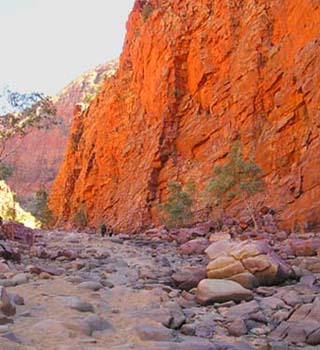 For
us the "Red Centre" of Australia was the arid country from Alice
Springs to Uluru. There are endless miles of rolling scrub and spinifex
plains, broken by dramatic mountain ranges. We spent much of our
birding time in the West MacDonnell Range, most of which is within West
MacDonnell National Park. There was some spectacular scenery (Ormiston Gorge,
right) and some long hikes (Rita on the Ormiston Pound hike, above; the
hike took us 6 hours!), but both birds and mammals were in low
densities. Partly this was due to the timing of our visit — the austral
winter — and the daily cold and windy weather, and partly due to the
effects of a long–running drought. Many spinifex specialties were just
plain missing.
For
us the "Red Centre" of Australia was the arid country from Alice
Springs to Uluru. There are endless miles of rolling scrub and spinifex
plains, broken by dramatic mountain ranges. We spent much of our
birding time in the West MacDonnell Range, most of which is within West
MacDonnell National Park. There was some spectacular scenery (Ormiston Gorge,
right) and some long hikes (Rita on the Ormiston Pound hike, above; the
hike took us 6 hours!), but both birds and mammals were in low
densities. Partly this was due to the timing of our visit — the austral
winter — and the daily cold and windy weather, and partly due to the
effects of a long–running drought. Many spinifex specialties were just
plain missing. 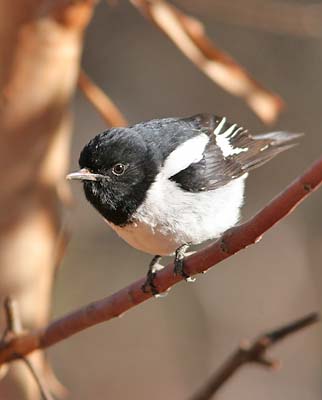

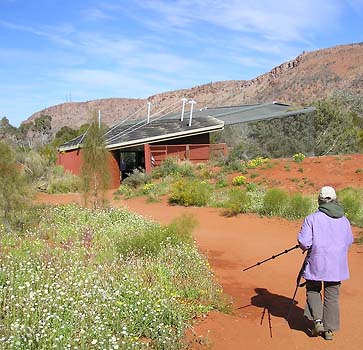 Just
outside of Alice Springs is a tourist attraction known as the "Desert
Park." It is a well-designed zoo with individual modules with captive
birds and mammals, but one strolls through desert habitat between
modules (left). There are some really nice aviaries with rare birds,
but wild birds are so tame on the grounds that I'm not sure whether I
took this photo of Spiny-cheeked Honeyeater (above) inside or out! The reptile modules, the Numbat, and the nocturnal exhibits were particularly exceptional here.
Just
outside of Alice Springs is a tourist attraction known as the "Desert
Park." It is a well-designed zoo with individual modules with captive
birds and mammals, but one strolls through desert habitat between
modules (left). There are some really nice aviaries with rare birds,
but wild birds are so tame on the grounds that I'm not sure whether I
took this photo of Spiny-cheeked Honeyeater (above) inside or out! The reptile modules, the Numbat, and the nocturnal exhibits were particularly exceptional here. 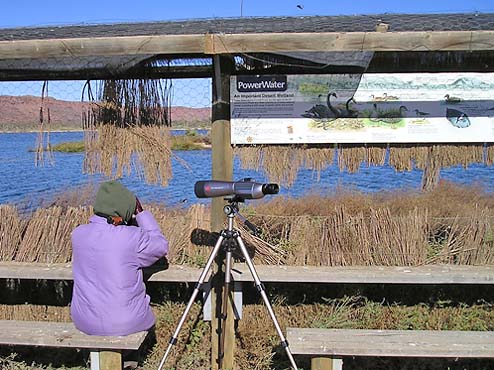 At
the time of our visit, the Alice Spring wastewater treatment ponds had
hides for birders (right) and a logbook, plus maps and birding signs.
There had also been a recent planned burn on the edge of the ponds,
where the logbook said two species of Australian chats had been seen,
but we found only a few Red-capped Robins.
At
the time of our visit, the Alice Spring wastewater treatment ponds had
hides for birders (right) and a logbook, plus maps and birding signs.
There had also been a recent planned burn on the edge of the ponds,
where the logbook said two species of Australian chats had been seen,
but we found only a few Red-capped Robins.
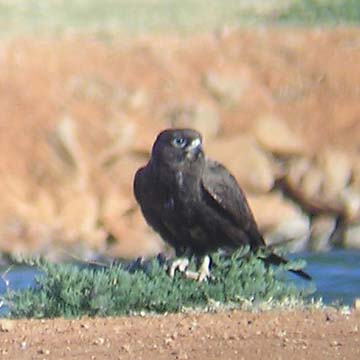
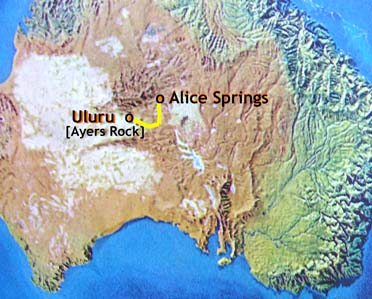 Until
we went to the Red Centre, we had no idea of the distance between Alice
Springs and Uluru (Ayers Rock; map right). It is hundreds of miles of
spinifex; the drive takes about 6 hours, not including stops. So it is
certainly not an easy one-day trip. Rather, we had arranged to fly into
Alice and out of Uluru [through a Qantas package fare and one-way
rental car deal], so we needed to do the long drive only once.
Until
we went to the Red Centre, we had no idea of the distance between Alice
Springs and Uluru (Ayers Rock; map right). It is hundreds of miles of
spinifex; the drive takes about 6 hours, not including stops. So it is
certainly not an easy one-day trip. Rather, we had arranged to fly into
Alice and out of Uluru [through a Qantas package fare and one-way
rental car deal], so we needed to do the long drive only once. 
